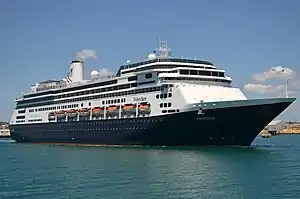Holland America Line
Holland America Line is a US-owned cruise line, a subsidiary of Carnival Corporation & plc headquartered in Seattle, Washington, United States.
 | |
| Type | Subsidiary |
|---|---|
| Industry | |
| Founded | 1873 (as Netherlands-America Steamship Company) in Rotterdam, Netherlands |
| Successor | Nederlandsche Scheepvaart Unie |
| Headquarters | Seattle, Washington, U.S. |
Key people |
|
| Products | Cruises |
| Parent | Carnival Corporation & plc |
| Website | www |
Holland America Line was founded in Rotterdam, Netherlands, and from 1873 to 1989, it operated as a Dutch shipping line, a passenger line, a cargo line and a cruise line operating primarily between the Netherlands and North America. As part of the company's legacy, it was directly involved in the transport of many hundreds of thousands of emigrants from the Netherlands to North America.[2]
Holland America has been a subsidiary of Carnival Corporation since 1989.[3]
History
Early decades
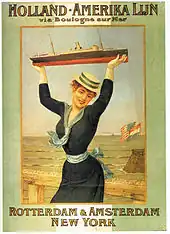
Holland America Line was founded in 1873, as the Nederlandsch-Amerikaansche Stoomvaart Maatschappij (Dutch-American Steamship Company), in short Holland-Amerika Lijn, a shipping and passenger line.[4] It was headquartered in Rotterdam, in the building which is now the Hotel New York.[5] The company was formed as a result of the reorganization of an earlier company, Plate, Reuchlin & Co. The company's first ship was the original Rotterdam (1872), which sailed its 15-day maiden voyage from the Netherlands to New York City on October 15, 1872. Cargo service to New York started in 1909.
HAL's main route was between Rotterdam and New York. Its "New York" terminal was in fact in Hoboken, New Jersey, on the opposite side of the Hudson River from New York City. By 1892, HAL ships sailing between Rotterdam and Hoboken were scheduled to call en route at Boulogne in France.[6]
In its first 25 years, the company carried 400,000 people from Europe to the Americas. Other North American ports were added during the early 20th century.[2]
Larger ships

Harland & Wolff in Belfast launched the third Rotterdam (1897).[7] She was the first HAL ship built by H&W. H&W next launched Statendam (1898):[8] the first HAL ship of that name, and the first HAL ship of more than 10,000 GRT. In 1899 Blohm+Voss in Hamburg launched Potsdam, which was 550 feet (170 m) long and 12,606 GRT.[9] H&W built two sister ships for Potsdam: Rijndam (1901)[10] and Noordam (1902).[11]
In 1902 William Pirrie, Chairman of H&W, negotiated to buy 51 percent of HAL's share capital. Pirrie was acting on behalf of J. P. Morgan's International Mercantile Marine Company (IMM), which already owned HAL's Belgian competitor Red Star Line. Pirrie did not disclose the fact that IMM had formed a cartel with Albert Ballin's Hamburg America Line (HAPAG) and Norddeutscher Lloyd (NDL), and wanted to buy HAL to control passenger and cargo rates across the North Atlantic.[12]
HAL continued to order ever larger ships from H&W. Nieuw Amsterdam (1905) was 600 feet (180 m) long and 16,967 GRT.[13] The fourth Rotterdam (1908) was 650 feet (200 m) long and 24,149 GRT.[14]
In 1895 HAL offered its first cruise. Its second cruise, from New York to Palestine, was offered in 1910.
First World War
In July 1914 H&W launched a new Statendam that was 740 feet (230 m) and 32,120 GRT. However, a month later, the First World War started, and in 1915 the UK government requisitioned the new ship in H&W's shipyard and had her completed as the troopship Justicia. A U-boat sank her in 1918, and HAL accepted the UK government's offer of 60,000 tons of steel as compensation.[15]
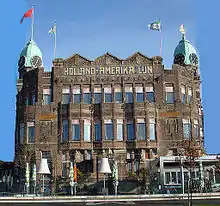
In the First World War the Netherlands were neutral, but numerous Dutch merchant ships were sunk. HAL lost five cargo ships, totalling more than 30,000 GRT. In 1915 two German mines sank Eemdijk,[16] and in 1916 U-53 stopped and sank Blommersdijk.[17] On 22 February 1917 U-21 sank an entire Dutch convoy, including the HAL ships Noorderdijk and Zaandijk.[18][19]
After the First World War began, Dutch capitalists bought HAPAG and NDL's shares in HAL. In December 1917, the same Dutch interests paid $3.5 million for half of IMM's shares in HAL. This amounted to about $800 per share, which was far more than IMM had paid for them in 1902. In 1916, IMM had received a dividend of 50 percent on its HAL shareholding.[20]
In March 1918 President Woodrow Wilson issued a proclamation seizing under angary 89 Dutch merchant ships in US ports. They included the HAL liner Rijndam, which was converted into a US troopship,[21] and eight HAL cargo ships. One of these, Oosterdijk, was sunk in a collision while being used by the United States Navy.[22] The United States Shipping Board returned Rijndam and the surviving cargo ships to HAL in the course of 1919.
Between the World Wars
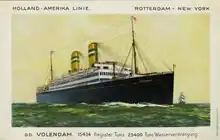
In 1921–22 HAL introduced its first steam turbine passenger liners: the 8,800 GRT Maasdam, Edam, Leerdam and Spaardnam. They served a route between Rotterdam and Tampico in Mexico. On westbound voyages, their ports of call were Antwerp, Boulogne, Bilbao, Santander, Gijón, A Coruña, Vigo, Havana and Vera Cruz. On eastbound voyages, they called at Vera Cruz, New Orleans, Havana, A Coruña and Santander.[6][23]
In 1922 H&W launched two larger passenger liners for HAL's Rotterdam – Hoboken route: the 15,000 GRT Volendam and Veendam.[24][25] By 1925 the Rotterdam – Hoboken route included calls at Southampton and Halifax, Nova Scotia on westbound crossings only, and Plymouth, Devon on eastbound crossings only, as well as serving Boulogne in both directions.[6]
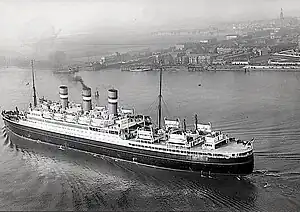
The third Statendam, built to replace Justicia, was also a turbine steamship, but building her took eight years. H&W laid her down in 1921 and launched her in 1924, but then stopped work because HAL lacked the funds to pay for her to be completed. In 1927 the Dutch government gave HAL a loan to get the ship towed to the Netherlands and completed at Wilton's Dok- en Werf Maatschappij in Schiedam. She was completed in 1929, on the eve of the Great Depression, but proved economical to run. She was HAL's flagship on the transatlantic run for most of the 1930s. Statendam also gave annual winter cruises from New York, usually to the Caribbean.[26]
In 1920 van der Giessen & Zonen in Krimpen aan den IJssel launched Burgerdijk,[27] which was HAL's first steam turbine cargo ship. She was the first of eight 6,850 GRT sister ships, all with a name beginning with "B", built between 1920 and 1922. In 1922 and 1923 Scheepsbouw-Maatschappij 'Nieuwe Waterweg' in Scheidam launched a pair of larger turbine cargo ships for HAL, the 8,350 GRT Gaasterdijk and Grootendijk.[28][29] However, HAL sold both ships in 1931.[28][29]
In 1921 and 1922 H&W launched the 9,350 GRT Dinteldijk and Drechtdijk, which were HAL's first motor ships. They were refrigerated cargo ships, and they also had berths for 18 or 19 first class passengers.[30][31] In 1929 and 1930 Wilton's in Schiedam launched two more motor ships for refrigerated cargo, the 10,200 GRT Delftdijk and Damsterdijk. These were cargo liners, with berths for 50 first class passengers.[32][33]
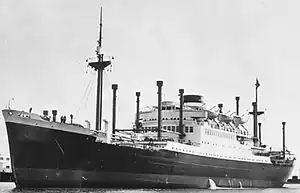
By 1930 HAL was operating routes between Rotterdam and the British Columbia Coast via London, Panama Canal and West Coast of the United States.[34] By 1937 HAL worked these routes jointly with Royal Mail Lines. This was mainly a refrigerated cargo service, but the ships carried some passengers. Damsterdijk, Delftdijk, Dinteldijk and Drechtdijk shared the route with RML's refrigerated cargo ships Lochmonar, Lochkatrine and Lochgoil. As well as London, they were scheduled to call at various other ports in Britain, the Caribbean, California, Oregon, Washington and British Columbia, terminating at Vancouver. On westbound voyages Damsterdijk, Delftdijk and Lochmonar also served Guayaquil in Ecuador, whereas Dinteldijk, Drechtdijk, Lochkatrine and Lochgoil served Bermuda.[6]
A new HAL flagship, the 36,287 GRT Nieuw Amsterdam, was launched in 1937 and entered service in 1938.[35] In 1939 HAL bought the former Red Star liners Westernland and Pennland, a pair of 16,000 GRT sister ships that Nazi Germany had forced the Jewish shipping magnate Arnold Bernstein to forfeit.[36][37]
Second World War
In the Second World War, HAL lost five passenger ships and eight cargo ships: a total of more than 140,000 GRT. Three were while the Netherlands were still neutral. Mines sank Binnendijk and Spaarndam in October and November 1939,[38][39] and U-48 sank Burgerdijk in February 1940.[40]
On 10 May Germany invaded the Netherlands. A number of HAL ships were burnt out in the battle for Rotterdam, including the liner Statendam and cargo ships Boschdijk and Dinteldijk. Statendam was scrapped three months later.[26] German forces towed Boschdijk to the Baltic, where the Luftwaffe used her for target practice until she sank in April 1942.[41] German forces scuttled Dinteldijk as a blockship in 1944.[30]
By 27 May, Germany had occupied the whole of the Netherlands. By 7 June, the Dutch government-in-exile and the UK government had formed a British-Netherlands shipping committee in London, and NASM announced that it would charter to the UK government all of its transatlantic ships except Nieuw Amsterdam.[42] Pennland became a troop ship.[37] The Dutch government-in-exile requisitioned Westernland, berthed at Falmouth, Cornwall. She became an accommodation ship for the Royal Netherlands Navy, and was later sold to the UK Admiralty.[36] By October 1940 Nieuw Amsterdam had also become an Allied troop ship. She sailed half a million miles and carried 400,000 military personnel.
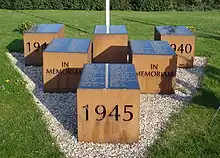
Nearly 200 people were killed in wartime sinkings of HAL ships. The biggest loss of life was in November 1942, when U-174 sank the cargo-passenger ship Zaandam. 135 of her passengers and crew were killed.[43] 39 people were killed in January 1941, when a mine sank the cargo ship Beemsterdijk.[44]
In October 1940 U-38 sank Bilderdijk.[45] In 1941 U-564 sank the cargo-passenger liner Maasdam, and an air attack in German invasion of Greece sank the troopship Pennland.[37][46] In September 1942, U-34 sank Breedijk.[47] In 1940 German forces requisitioned Drechtdijk. In 1945 she hit a mine in the Baltic, and a week later was badly damaged in an air raid.[31]
Post-war era
_(cropped).jpg.webp)
After the war, HAL took part in transporting a great wave of immigrants from the Netherlands to Canada and elsewhere.[48] Its Rotterdam – Hoboken route continued to serve Southampton, but by 1948 the port of Boulogne was still not in a condition to resume handling large ocean liners. Instead, from February 1948 Nieuw Amsterdam started calling at Le Havre as well as Southampton. At first she was the only HAL ship to do so. Veendam made intermediate calls at Southampton only, and Noordam and Westerdam ran direct between Rotterdam and Hoboken.[49] By 1959 HAL ships were calling also at Cobh, and running a service to Quebec and Montreal. By 1963 they also served Bremerhaven.[6]
A notable ship in the post-war era was the fifth Rotterdam, launched in 1959. She was one of the first North Atlantic ships equipped for two-class transatlantic crossing and one-class luxury cruising.
By the late 1960s, the golden era of transatlantic passenger ships had been ended by the introduction of transatlantic jet air travel. HAL ended transatlantic service in the early 1970s, leaving the North Atlantic passenger trade for Cunard Line's Queen Elizabeth 2.
In 1973, it sold its cargo shipping division, which continued to operate freight liner services with cargo ships, a Lighter aboard ship ('LASH' ship, MV Bilderdyk) and then container ships under the trade name Incotrans, with headquarters in Rotterdam, with some of its North American services operated in partnership with the French shipping line Compagnie Générale Maritime.
HAL ceased operating as a Dutch line in 1989, when Carnival bought it for 1.2 billion guilders (€530 million). The proceeds were put into an investment company (HAL Investments), the majority of which is owned by the van der Vorm family.
Former fleet (before 1989)
HAL ships sold, scrapped or lost before Carnival took over.[48]
- SS Aagtedijk, 1950–63 — Launched in 1945 as Turand. Spelling changed to Aagtedyk in 1953. Scrapped after a collision.[50]
- Beemsterdijk, 1922 — Sunk by a mine in 1941.[44]
- SS Beukelsdijk, 1916 — Wrecked on rocks in 1923.[51]
- SS Bilderdijk (I), 1922 — Sunk by torpedo by U-38 in 1940.[45]
- SS Binnendijk, 1921 — Sunk by a mine in 1939.[38]
- SS Blommersdijk (I), 1916 — Launched in 1907 as Blötberg. Sunk by shellfire by U-53 in 1916.[17]
- SS Boschdijk, 1922 — Burnt ont in 1940, sunk in 1942 as Luftwaffe target practice.[41]
- SS Breedijk, 1922 — Sunk by torpedo by U-34 in 1942.[47]
- SS Burgerdijk, 1921 — Sunk by torpedo by U-48 in 1940.[40]
- MV Damsterdijk, 1930 — Scrapped in 1966.[33]
- MV Delftdijk, 1929 — Scrapped in 1963.[32]
- MV Dinteldijk (I), 1922 — Burnt out in 1940, sunk as a blockship in 1944, scrapped in 1947.[30]
- MV Drechtdijk, 1923 — Captured by German forces in 1940, renamed Russelheim, sunk by an air attack in 1945.[31]
- SS Edam (I), 1881 — Sunk in a collision in 1882[52]
- SS Edam (II), 1883 — Sunk in a collision in 1895[53]
- SS Eemdijk (I), 1915 — Launched in 1913 as Oceanos. Sunk by a mine in 1915.[16]
- SS Gaasterdijk, 1922 — Sold in 1931, sunk in 1942.[28] Sister of Grootendijk.
- SS Gorredijk (I), 1909–23 — Launched in 1902 as Como. Sold and renamed Benmacdhui. Scrapped in 1931.[54]
- SS Groote Beer, 1951–63 — Launched in 1944, scrapped in 1971.[55]
- SS Grootendijk, 1923 — Sold in 1931, sunk in 1941.[29] Sister of Gaasterdijk.
- SS Leerdam (I), 1882 — Launched in 1881 as Nederland. Sunk in a collision in 1889.[56]
- SS Maartensdijk, 1909–23 — Built in 1902 as Rapallo. Sold and renamed Benvrackie. Scrapped in 1933.[57]
- SS Maasdam (III), 1921 — Sunk by torpedo by U-564 in 1941.[46]
- SS Maasdam (IV), 1952–68 — became Polish Ocean Lines' TSS Stefan Batory. Scrapped in 2000.[58]
- SS Nieuw Amsterdam (I), 1905–32 — Largest HAL ship until Rotterdam (IV) was completed in 1908.[59]
- SS Nieuw Amsterdam (II), 1937–74 — UK troopship in Second World War[35]
- SS Noordam (I), 1902 — Scrapped in 1927. Warned RMS Titanic of sea ice on the latter's maiden voyage.[60]
- MV Noordam (II), 1938 — Sold in 1963, scrapped in 1967.[61] Sister of Zaandam (II)
- SS Noorderdijk (I), 1913 — Sunk by torpedo by U-21 in 1917.[18]
- SS Oosterdijk, 1913–18 — Sister of Westerdijk. Sunk in a collision.[22]
- SS P. Caland, 1874–97. Sister of W. A. Scholten. Sold and renamed Ressel.[62]
- SS Pennland, 1939 — launched in 1920 as Pittsburgh. Troopship from 1940. Sunk by air raid in 1941.[37] Sister of Westernland.
- SS Potsdam, 1900–15 — Largest HAL ship when she entered service. Sold and renamed Stockholm. Scuttled in 1944, scrapped in 1947.
- MS Prinsendam, 1973–80 — Sank as a result of fire in her engine room.
- SS Rijndam (I), 1901 — US troopship 1918–19. Scrapped 1929.
- SS Rotterdam (I), 1873 — Wrecked in 1883.
- SS Rotterdam (II), 1886 — Scrapped in 1895.
- SS Rotterdam (III), 1897–1906 — Sold and renamed C. F. Tietgen. Sunk by torpedo by U-151 in 1918.[63]
- SS Rotterdam (IV), 1908 — Scrapped in 1940. Largest HAL ship until Statendam (III) entered service in 1929.
- SS Ryndam (II), 1951–73 — Sank in 2003 on her way to be scrapped.[58]
- MV Sloterdijk (II) 1940 — Sister of Sommelsdijk (III). US troopship in the Second World War. Dutch troopship in the Indonesian National Revolution. Scrapped in 1966.[64][65]
- SS Soestdijk (I), 1901–23 — Sold and renamed Callandia. Scrapped in 1931.[66]
- MV Sommelsdijk (III) 1939 — Wartime service as US troopship. Scrapped in 1965.[64][67]
- SS Spaarndam (II), 1922 — Combined passenger and cargo ship. Sunk by a mine in 1939 with the loss of six lives.[39]
- SS Statendam (I), 1898–1911 — Sold to Allan Line[8]
- SS Statendam (II) — Requisitioned before completion as the troopship SS Justicia[15]
- SS Statendam (III), 1929–40 — Scrapped after being burnt out at Rotterdam[26]
- SS Statendam (IV), 1956–82 — Last in service for Regent Star as Regency.[68]
- SS Veendam (I) 1888. Built in 1871 as Baltic. Sank in 1898 after striking a submerged wreck.[69]
- SS Veendam (II), 1923 — Sister of Volendam (I). In 1940, bombed in Rotterdam, repaired and requestioned by German forces. Used as submarine tender in Hamburg. Returned to HAL service 1947, scrapped in 1953.[25]
- SS Veendam (III), 1972–74, 1975–76, 1978–84 — Last in service for Commodore Cruise Line as Enchanted Isle[70]
- SS Veendijk 1914–33[71]
- SS Volendam (I), 1922–52 — 1940–45 Escaped to Britain in WW2, became troopship[24]
- SS Volendam (II), 1972–76, 1978–84 — Sister of Veendam (III); Later Universe Explorer of World Explorer Lines.[72]
- SS W. A. Scholten, 1874 — Sister of P. Caland. Sunk in a collision in 1887 with the loss of 122 lives.[73]
- SS Waterman, 1951–63 — Launched in 1945, scrapped in 1970.[55]
- MV Westerdam (I), 1940–65 — Cargo and first class passenger ship. Launched in 1940, but damaged by fire and not completed. Sunk in 1942, 1944 and 1945. Completed in 1946. Scrapped in 1965.[74]
- SS Westerdijk 1913–33 — Sister of Oosterdijk.[75]
- SS Westernland, 1939–43 — Launched in 1918 as Regina. Sold to the UK Admiralty.[36] Sister of Pennland.
- MV Zaandam (II), 1938 — Sunk by torpedo by U-174 in 1942 with the loss 134 lives.[43] Sister of Noordam (II)
- SS Zaandijk (I), 1909 — Built in 1899 as Ohio. Sunk by torpedo by U-21 in 1917.[19]
- SS Zuiderdijk, 1912–23 — Sold and renamed Misty Law. Scrapped in 1957.[76]
- SS Zuiderkruis, 1951–63 — Launched in 1944, scrapped in 1969.[55]
US-based cruise line (1989–present)
In 1989, the Holland America Line was bought by Carnival Corp, thus becoming an US–owned cruise line headquartered in Seattle, Washington, United States.[77]
In the summer of 2011, Rotterdam did two transatlantic crossings, the first traditional transatlantic runs made by the line in more than 40 years.
Beginning in September 2012, Rotterdam was based year-round out of Rotterdam, sailing to Europe, the Caribbean, as well as Asia, before returning to more varied itineraries and home ports by 2016.
Amsterdam makes annual "Grand Voyages" lasting more than 60 days, including a grand circle of the Pacific Ocean each fall and a World Voyage sailing around the world, usually ranging from January to April/May.
The line currently operates four different classes of ship: the R class, the Vista class, the Signature class, and the newest and largest Pinnacle class.[78]
All HAL ships have a dark blue hull with white superstructure, with the company's logo featured prominently on the functional smoke stacks.
Holland America also owns the following:
- the Westmark hotel chain operating in Alaska and the Yukon[79]
- Half Moon Cay, a private Caribbean island (known officially as Little San Salvador Island) with most Caribbean cruises spending a day there.
On October 26, 2012, it was announced that a memorandum of agreement had been signed with Italian shipbuilder Fincantieri for the construction of a 2,660-passenger ship for Holland America Line scheduled for delivery in spring 2016. Koningsdam, which became a new class of ship for the line (The Pinnacle Class), and the first new Holland America ship since Nieuw Amsterdam, delivered in 2010. Also noted was that the addition of new ships would maintain passenger capacity if some of the older Carnival Corporation ships are sold.[80]
The Holland America Group of HAL and Princess Cruises have a letter of understanding to buy the White Pass and Yukon Route between Skagway, Alaska and the US-Canadian border. The purchase closed July 31, 2018.
On July 15, 2020, it was announced by Holland America that Maasdam, Veendam, Rotterdam, and Amsterdam were sold to two undisclosed buyers. The ships were sold in pairs, with the Maasdam and Veendam transferring to one company in August 2020, while the Amsterdam and Rotterdam moved to another company in fall 2020. One pair went to a new cruise brand and the other to an existing brand.[81]
Most cruise lines suspended their sailings because of the COVID-19 pandemic in 2020.[82] As of 6 January 2021, all Holland America sailings were cancelled to at least 30 April 2021, according to an industry news item. That report listed no specific sailings for Holland America prior to the first week of June 2021.[83]
In October 2023, Holland America announced that it was about halfway through converting its fleet Wi-Fi to Starlink. The cruise line also announced that it expected to have Starlink fully operational across its entire fleet by mid-December 2023.[84] With the move, Holland America joined its sister-brands in Carnival Corporation & plc, including Princess Cruises and Cunard Line.[85]
Fleet
Current fleet
| Ship name | In HAL service |
Gross tonnage |
Maximum speed |
Passenger complement |
Enclosed passenger decks |
Flag | Image | |
|---|---|---|---|---|---|---|---|---|
| Rotterdam class (R class) | ||||||||
| Unlike the ships of the S class, Holland America Line's R-class ships did not all start out identical. Rotterdam, the first of the four, was similar to the S class, but slightly longer and wider, with a third set of passenger stairs/elevators, twin funnels, and some new facilities. The twin sister ships Volendam and Zaandam followed, similar to Rotterdam, but with a different (single) funnel and larger because the aft pool was moved up one deck to the Lido level, creating more space for passenger accommodations below. The final R-class ship, Amsterdam, like a hybrid of Rotterdam and Volendam/Zaandam, incorporates Rotterdam's twin funnels as well as the Lido deck aft pool. Together, Rotterdam and Amsterdam were considered HAL's flagships. On July 15, 2020, it was announced by Holland America that MS Rotterdam and MS Amsterdam were sold to an undisclosed buyers. The ships were sold in pairs, with the two joining an existing cruise brand in fall 2020.[81] It was further announced on the same day, that this pair will join Fred. Olsen Cruise Line.[81] | ||||||||
| MS Volendam | 1999 | 61,214 | 23 knots | 1,432 | 9 | 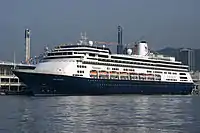 | ||
| MS Zaandam | 2000 | 61,396 | 23 knots | 1,432 | 9 | 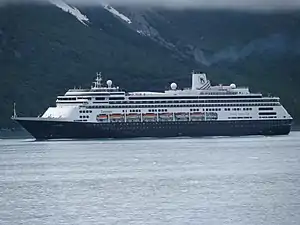 | ||
| Vista class (V class) | ||||||||
| HAL's four Vista-class ships are named for the points of the compass in Dutch. Noord for north, Zuid for south, Oost for east and West for West. These ships were designed mainly for shorter (less than two weeks) cruises in the Caribbean, Alaska and Europe. These ships are notable because of the exceptionally great number of oceanview and verandah staterooms - more than 85% and 67% respectively. The first three Vista-class ships were built as identical triplets. Noordam incorporated a few design changes, including a more vertical aft profile, which makes her larger, with a slightly greater passenger capacity. The success of Noordam's revised design caused HAL to modify the other three Vista-class ships with aft expansions to mimic Noordam. In 2006, the Vista-class cruise ships were awarded the 2006 Green Planet Award for outstanding environmental standards by Kuoni Switzerland.[86] Zuiderdam, Oosterdam and Westerdam received the first phase of Signature of Excellence upgrades (detailed above) between 2005 and 2006, while Noordam was built to SOE1 standards. | ||||||||
| MS Zuiderdam | 2002 | 82,305 | 24 knots | 1,916 | 10 | 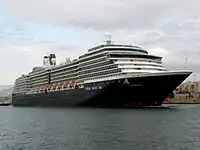 | ||
| MS Oosterdam | 2003 | 82,305 | 24 knots | 1,916 | 10 | .JPG.webp) | ||
| MS Westerdam | 2004 | 82,305 | 24 knots | 1,916 | 10 | 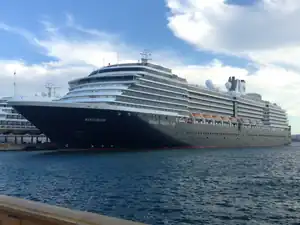 | ||
| MS Noordam | 2006 | 82,318 | 24 knots | 1,924 | 10 | 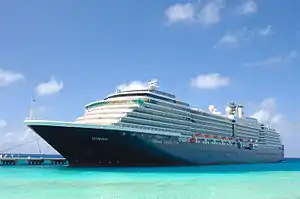 | ||
| Signature class | ||||||||
| The Signature-class ships are essentially an enhanced Vista-class design. The main difference is the addition of a deck between the Lido and Observation decks. This allows for more cabins (mostly spa accommodations) and some additional facilities including the specialty restaurant Tamarind and the Silk Den lounge. Both Signature-class ships were built to Signature of Excellence (first phase) standards (detailed above). | ||||||||
| MS Eurodam | 2008 | 86,273 | 23.9 knots | 2,104 | 11 | 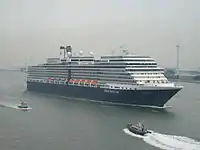 | ||
| MS Nieuw Amsterdam | 2010 | 86,700 | 23.9 knots | 2,106 | 11 | 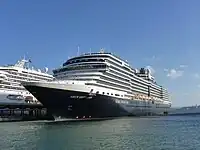 | ||
| Pinnacle class | ||||||||
| Constructed at the Fincantieri shipyards, Koningsdam is the largest ship to be built for Holland-America, and is the size of the ex-Ryndam and ex-Statendam joined together.[80] The new ship has a beam of 35 metres (114 ft 10 in), complying with the New Panamax dimensions and allowing it to cruise through the new wider locks currently under construction at the Panama Canal. It was launched on February 15, 2016.[87] All Pinnacle class ships were built to Signature of Excellence (first phase) standards (detailed above). | ||||||||
| MS Koningsdam | 2016 | 99,863 | 22,2 knots | 2,650 | 12 | _004.jpg.webp) | ||
| MS Nieuw Statendam | 2018 | 99,863 | 22,2 knots | 2,650 | 12 | .jpg.webp) | ||
| MS Rotterdam | 2021 | 99,863 | 22,2 knots | 2,650 | 12 |  | ||
Former fleet
Holland America's parent company, Carnival Corporation & plc, currently owns two former Holland America Line ships operated by Marella Cruises. Both Marella Celebration and Marella Spirit sailed for Holland America as the Noordam (1984) and Nieuw Amsterdam (1983) before being transferred to the Marella fleet in 2005 and 2003, respectively. Marella Spirit was operated by Louis Cruises under sub-charter to Marella until 2018, when she was sold for scrap. Her sister ship, the Marella Celebration, still remains in operation. Marella Dream was built as Homeric in 1986 before moving to Holland America as Westerdam in 1988.
When Carnival Corporation acquired Costa Cruises in 2000, she was then transferred to the Costa fleet as Costa Europa in 2002. She has since been under charter to Marella since 2010.[88] It was announced on May 19, 2014 that both the Statendam and Ryndam would be transferred to P&O Cruises Australia fleet.[89]
| Ship name | Built | In HAL service | Gross tonnage | Current flag | Notes | Image |
|---|---|---|---|---|---|---|
| Amsterdam | 2000 | 2000–2020 | 62,735 tons | Rotterdam class Sold to Fred. Olsen Cruise Line in 2020 and renamed Bolette. | 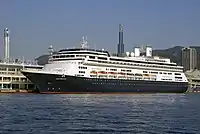 | |
| Rotterdam | 1997 | 1997–2020 | 61,849 tons | Rotterdam class Sold to Fred. Olsen Cruise Line in 2020 and renamed Borealis. | 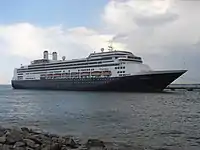 | |
| Veendam | 1996 | 1996–2020 | 57,092 tons | Statendam class (S class) As the first ships ordered and delivered under the line's ownership by Carnival Corporation & plc, the S-class ships were the first new Holland America Line ships to incorporate features including the atrium, the two-deck main dining room and show lounge, and the Lido pool with retractable roof.[90] Sold to Seajets in 2020 and renamed Aegean Majesty.[81] | .jpg.webp) | |
| Ryndam | 1994 | 1994–2015 | 55,819 tons | Statendam class (S class) MS Ryndam for Holland America Line from 1994 to 2015. Pacific Aria for P&O Cruises Australia from 2015 to 2020. After the deal to sell to CMV failed due to their administration P&O sold Pacific Aria to Seajets.[91] |  | |
| Maasdam | 1993 | 1993–2020 | 55,575 tons | Statendam class (S class) sold to Seajets in 2020 and renamed Aegean Myth. [81] | _(9450771460).jpg.webp) | |
| Statendam | 1993 | 1993–2015 | 55,819 tons | Statendam class (S class) MS Statendam for Holland America Line from 1992 to 2015. Pacific Eden for P&O Cruises Australia from 2015 to 2019. Vasco da Gama for TransOcean Tours since 2019. After CMV entered administration in 2020 sold to Mystic Invest.[92] | 02.jpg.webp) | |
| Prinsendam | 1988 | 2002–19 | 38,848 tons | Prinsendam had a career with Royal Viking Line, Cunard Line, and Seabourn Cruise Line before joining the HAL fleet after an extensive refit in 2002. Transferred to Phoenix Reisen and renamed Amera in 2019 | 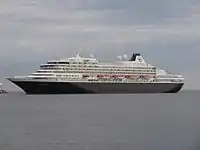 | |
| Westerdam | 1986 | 1988–2002 | 54,763 tons | Homeric for Home Lines from 1986 to 1988. MS Westerdam for Holland America Line from 1988 to 2002. Costa Europa for Costa Cruises from 2002 to 2010. Marella Dream for Marella Cruises from 2010 to 2020. Laid up from 2020 to 2022. Sold for scrap as Ella in 2022. | .jpg.webp) | |
| Noordam | 1984 | 1984–2005 | 33,960 tons | MS Noordam for Holland America Line from 1984 to 2005. Marella Celebration for Marella Cruises from 2005 to 2020. Laid up from 2020 to 2022. Sold for scrap as Mare in 2022. | _(noordam).jpg.webp) | |
| Nieuw Amsterdam | 1983 | 1984–2000 | 33,930 tons | MS Nieuw Amsterdam for Holland America Line 1983 to 2000. MS Patriot for American Classic Voyages from 2000 to 2002. Laid up as MS Nieuw Amsterdam by Holland America Line 2002. MS Spirit for Louis Cruise Lines from 2002 to 2003. Marella Spirit for Marella Cruises from 2003 to 2018. Sold for scrap as Mare S and La Spirit in 2018 | .jpg.webp) | |
| Rotterdam | 1959 | 1959–97 | 38,645 tons | SS Rotterdam for Holland America Line from 1959 to 1997. Rembrandt for Premier Cruises from 1997 to 2000. Laid up as Rembrandt from 2000 to 2003. SS Rotterdam for WestCord Hotels since 2013. | .jpg.webp) |
See also
References
Notes
- "Carnival Corporation announces important moves within its leadership team". eTurboNews. 9 July 2020. Retrieved 4 August 2020.
- "Holland America Line – A History of Distinction, Innovation and Growth". The Maritime Executive. 22 December 2010. Retrieved 14 October 2020.
- "Carnival Buys Up Holland America". Los Angeles Times. 12 February 1989. Retrieved 11 January 2021.
$625-million purchase
- "Holland Line Jubilee". News-Pilot. San Pedro, California. 20 April 1948. p. 14.
- "Hotel New York and Lloyd Hotel: migration stopovers between Europe and the Americas". blog.europeana.eu. Europeana (CC BY-SA). 7 November 2018. Retrieved 30 November 2018.
- Larsson, Björn (24 June 2019). "Holland-America Line". Marine Timetable Images. Retrieved 7 June 2023.
- "Rotterdam – ID 5591". Stichting Maritiem-Historische Databank (in Dutch). Retrieved 6 June 2023.
- "Statendam – ID 6176". Stichting Maritiem-Historische Databank (in Dutch). Retrieved 6 June 2023.
- "Potsdam – ID 5248". Stichting Maritiem-Historische Databank (in Dutch). Retrieved 15 May 2023.
- "Noordam – ID 5630". Stichting Maritiem-Historische Databank (in Dutch). Retrieved 6 June 2023.
- "Noordam – ID 4701". Stichting Maritiem-Historische Databank (in Dutch). Retrieved 6 June 2023.
- "The White Star Line and the International Mercantile Marine Company". Titanic Historical Society, Inc. Retrieved 6 June 2023.
- "Nieuw Amsterdam – ID 4633". Stichting Maritiem-Historische Databank (in Dutch). 6 June 2023.
- "Rotterdam – ID 5592". Stichting Maritiem-Historische Databank (in Dutch). 6 June 2023.
- "Justicia". Harland and Wolff Shipbuilding and Engineering Works. Retrieved 6 June 2023.
- "Eemdyk – ID 1900". Stichting Maritiem-Historische Databank (in Dutch). Retrieved 2 June 2023.
- Helgason, Guðmundur. "Blommersdijk". uboat.net. Retrieved 2 June 2023.
- Helgason, Guðmundur. "Noorderdijk". uboat.net. Retrieved 2 June 2023.
- Helgason, Guðmundur. "Zaandijk". uboat.net. Retrieved 2 June 2023.
- "Mercantile Marine sells Dutch stock". The New York Times. 21 December 1917. p. 16. Retrieved 28 June 2023 – via Times Machine.
- "Rijndam". DANFS. Naval History and Heritage Command. 29 September 2005. Retrieved 6 June 2023.
- "Oosterdyk– ID 4893". Stichting Maritiem-Historische Databank (in Dutch). Retrieved 2 June 2023.
- Talbot-Booth 1936, p. 498.
- "Volendam – ID 7073". Stichting Maritiem-Historische Databank (in Dutch). Retrieved 6 June 2023.
- "Veendam – ID 6942". Stichting Maritiem-Historische Databank (in Dutch). Retrieved 6 June 2023.
- "Statendam – ID 6177". Stichting Maritiem-Historische Databank (in Dutch). Retrieved 4 June 2023.
- "Burgerdyk – ID 1175". Stichting Maritiem-Historische Databank (in Dutch). Retrieved 6 June 2023.
- "Gaasterdyk – ID 2352". Stichting Maritiem-Historische Databank (in Dutch). Retrieved 6 June 2023.
- "Grootendyk – ID 2592". Stichting Maritiem-Historische Databank (in Dutch). Retrieved 6 June 2023.
- "Dinteldyk – ID 1710". Stichting Maritiem-Historische Databank (in Dutch). Retrieved 6 June 2023.
- "Drechtdyk – ID 1792". Stichting Maritiem-Historische Databank (in Dutch). Retrieved 6 June 2023.
- "Delftdyk – ID 1642". Stichting Maritiem-Historische Databank (in Dutch). Retrieved 2 June 2023.
- "Damsterdyk – ID 1598". Stichting Maritiem-Historische Databank (in Dutch). Retrieved 2 June 2023.
- Harnack 1930, p. 399.
- "Nieuw Amsterdam – ID 4634". Stichting Maritiem-Historische Databank (in Dutch). Retrieved 6 June 2023.
- "Westernland – ID 7246". Stichting Maritiem-Historische Databank (in Dutch). Retrieved 6 June 2023.
- "Pennland – ID 5111". Stichting Maritiem-Historische Databank (in Dutch). Retrieved 6 June 2023.
- "Binnendyk – ID 981". Stichting Maritiem-Historische Databank (in Dutch). Retrieved 2 June 2023.
- "Spaarndam – ID 6060". Stichting Maritiem-Historische Databank. Retrieved 2 June 2023.
- Helgason, Guðmundur. "Burgerdijk". uboat.net. Retrieved 2 June 2023.
- "Boschdyk – ID 1067". Stichting Maritiem-Historische Databank (in Dutch). Retrieved 2 June 2023.
- "Allies to charter many Dutch ships". The New York Times. 8 June 1940. p. 34. Retrieved 10 June 2023 – via Times Machine.
- Helgason, Guðmundur. "Zaandam". Uboat.net. Retrieved 7 March 2012.
- "Beemsterdyk – ID 873". Stichting Maritiem-Historische Databank. Retrieved 2 June 2023.
- Helgason, Guðmundur. "Bilderdijk". uboat.net. Retrieved 2 June 2023.
- Helgason, Guðmundur. "Maasdam". uboat.net. Retrieved 20 January 2014.
- Helgason, Guðmundur. "Breedijk". uboat.net. Retrieved 2 June 2023.
- Dalkmann, H.A.; Schoonderbeek, A.J. (1998). 125 Years of Holland America Line. Edinburgh: The Pentland Press Ltd. pp. 5–17. ISBN 1-85821-590-0.
- "Liner Nieuw Amsterdam To Call at a French Port". The New York Times. 12 January 1948. p. 39. Retrieved 12 June 2023 – via Times Machine.
- "Aagtedyk – ID 5". Stichting Maritiem-Historische Databank (in Dutch). Retrieved 2 June 2023.
- "Grängesberg – ID 8485". Stichting Maritiem-Historische Databank (in Dutch). Retrieved 2 June 2023.
- "Edam – ID 8172". Stichting Maritiem-Historische Databank (in Dutch). Retrieved 2 June 2023.
- "Edam – ID 1882". Stichting Maritiem-Historische Databank (in Dutch). Retrieved 2 June 2023.
- "Gorredyk – ID". Stichting Maritiem-Historische Databank (in Dutch). Retrieved 2 June 2023.
- "SS Zuiderkruis, Groote Beer, Waterman". www.ssmaritime.com.
- "Nederland – ID 8268". Stichting Maritiem-Historische Databank (in Dutch). Retrieved 2 June 2023.
- "Maartensdyk – ID 3842". Stichting Maritiem-Historische Databank (in Dutch). Retrieved 2 June 2023.
- "Holland America Ocean Liner Postcards". www.simplonpc.co.uk.
- "Nieuw Amsterdam – ID 4633". Stichting Maritiem-Historische Databank (in Dutch). 2 June 2023.
- "Some History of the MS Noordam". Cruise Information. Bill Watts Family.
- "Noordam – ID 4702". Stichting Maritiem-Historische Databank (in Dutch). 6 June 2023.
- "P. Caland – ID 8298". Stichting Maritiem-Historische Databank. Retrieved 2 June 2023.
- Helgason, Guðmundur. "Dwinsk". Uboat.net. Retrieved 7 March 2012.
- Swiggum, Susan; Kohli, Marjorie (18 January 2006). "Nederlandsch-Amerikaansche Stoomvaart Maatschappij / Holland America Line". TheShipsList. Retrieved 18 December 2013.
- Van Kuijk, John. "Sloterdyk (2) (1940 – 1966)" (in Dutch). Vereniging de Lijn. Retrieved 22 November 2021.
- "Soestdyk – ID 6033". Stichting Maritiem-Historische Databank. Retrieved 2 June 2023.
- Lloyd's Register of Shipping (PDF). Vol. II.–Steamers & Motorships of 300 Tons, Trawlers, Tugs, Dredgers, etc. London: Lloyd's Register of Shipping. 1943. Retrieved 18 December 2013 – via Southampton City Council.
- "Holland America – Statendam (1956) Ocean Liner and Cruise Ship Postcards". www.simplonpc.co.uk.
- "Veendam – ID 6939". Stichting Maritiem-Historische Databank. Retrieved 2 June 2023.
- "Moore-McCormack Liner Argentina 1958 – Ship Postcards". www.simplonpc.co.uk.
- "Veendyk – ID 6945". Stichting Maritiem-Historische Databank. Retrieved 2 June 2023.
- "Moore-McCormack Liner Brasil 1958 – Ship Postcards". www.simplonpc.co.uk.
- "W. A. Scholten – ID 8382". Stichting Maritiem-Historische Databank. Retrieved 2 June 2023.
- "Westerdam – ID 7233". Stichting Maritiem-Historische Databank. Retrieved 12 June 2023.
- "Oosterdyk– ID 7237". Stichting Maritiem-Historische Databank (in Dutch). Retrieved 2 June 2023.
- "Zuiderdyk – ID 7501". Stichting Maritiem-Historische Databank. Retrieved 2 June 2023.
- "Estonia".
- "Vista Class". Holland America Line. Retrieved 13 August 2019.
- "About Us". Westmark Hotels – Alaska/Yukon. Retrieved 1 July 2015.
- "Carnival Cruise Lines and Holland America Line Order New Ships". Cruise Industry News. 26 October 2012.
- "Four Holland America Line Ships Sold". Cruise Industry News. 15 July 2020.
- "First Large Cruise Line With 2 Ships Back In Operation". Travel Off Path. 20 September 2020.
As of 19 September "Costa became the first large cruise line to relaunch the operations of a second ship"
- "Holland America and Princess Cruises Extend Suspensions". Cruise Hive. 6 January 2021.
The cruise line which has been hit hard by the global pandemic has announced a further suspension on cruise operations.
- "Holland America Rolls Out Starlink to More than Half of Fleet". www.travelmarketreport.com. 2023-10-02. Retrieved 2023-10-03.
- "Cunard Rolls Out Starlink Wi-Fi". www.travelmarketreport.com. 2023-09-19. Retrieved 2023-10-03.
- Sailing the Seas of Green Archived 8 February 2007 at the Wayback Machine
- "Holland America Line Confirms Date, Size and Class of New Build Cruise Ship - Holland America Line". www.cruisecritic.com.
- "Costa charters Costa Europa for Thomson Cruises (see also Latest News story below)". 8 July 2011. Archived from the original on 8 July 2011. Retrieved 25 March 2020.
- "Ryndam and Statendam to P&O Australia as AU Growth for Carnival Corp. Continues". Cruise Industry News. 19 May 2014. Retrieved 20 May 2014.
- "0004 An Outline of the History of Holland America Line part 4". Captain Albert's Website and Blog. Retrieved 26 March 2020.
- "Iliopoulos strikes again with another Carnival cruiseship buy". TradeWinds | The Global Shipping News Source. 14 October 2020. Retrieved 17 October 2020.
- "Mystic Cruises buys Vasco da Gama, first CMV ship to be auctioned". seatrade-cruise.com. 13 October 2020. Retrieved 17 October 2020.
Bibliography
- de Balbian Verster, J.F.L. (1921). Holland-America: an historical account of shipping and other relations between Holland and North America. Amsterdam: Bernard Houthakker for the Holland America Line. OCLC 19792377.
- van Berkum, Sandra; Maes, Tal (2011). Captain's Dinner: Koken met de Holland-Amerika Lijn [Captain's Dinner: Cooking with the Holland America Line] (in Dutch). Schiedam: Scriptum. ISBN 978-9055948161.
- de Boer, G.J. (1998). 125 jaar Holland-Amerika Lijn, 1873–1998 [125 Years Holland America Line, 1873–1998] (in Dutch). Alkmaar: De Alk. ISBN 906013074X.
- de Boer, Michiel George (1923). Holland-America Line, 1873–1923. Rotterdam: Holland America Line. OCLC 602295517.
- Card, Stephen J. (2005). Holland America Line, "The Spotless Fleet" : Maritime Paintings. London: Carmania Press. ISBN 0954366654.
- Collard, Ian (2018). Holland America Cruise Ships. Stroud: Amberley Publishing. ISBN 978-1445667607.
- Dalkmann, H.A.; Schoonderbeck, A.J. (1998). 125 years of Holland America Line: a company history. Edinburgh: Pentland Press. ISBN 1858215900.
- Gischler, Arnout C. (2003). De Holland-Amerika Lijn in Zwaar Weer [The Holland America Line in Heavy Weather]. Historische publicaties Roterodamum series, no. 148 (in Dutch). Zutphen: Walburg Pers. ISBN 9057302624.
- de Groot, Edward P. (1980). Per mailboot naar Amerika: vijftig jaar Noordatlantische passagiersvaart onder Nederlandse vlag [By Mail Boat to America: Fifty years of North Atlantic passenger travel under the Dutch flag] (in Dutch). Bussum: Unieboek. ISBN 9022818314.
- Guns, Nico (2004). Holland America Line: Short History of a Shipping Company. Zutphen: Walburg Pers. ISBN 9057303167.
- Guns, Nico; van Rikxoort, Ronald (2006). Holland-Amerika Lijn: Schepen van 'De Lijn' in beeld [Holland America Line: Ships of 'The Line' in focus] (in Dutch). Zutphen: Walburg Pers. ISBN 9057304600.
- Guns, Nico (2013). Een zeevarend zondagskind: de memoires van HAL-kapitein Roelof ten Kate [A Seafaring Sunday's Child: the memoirs of HAL Captain Roelof ten Kate] (in Dutch). Zutphen: Walburg Pers. ISBN 978-9491354281.
- Harnack, Edwin P (1930) [1903]. All About Ships & Shipping (4th ed.). London: Faber and Faber.
- Haws, Duncan (1995). Holland America Line. Merchant Fleets series. Vol. 28. Uckfield: Travel Creatours Ltd Publications. ISBN 0946378258.
- van Herk, C.; van der Elst, J.H. (1981). De schepen van de Holland Amerika Lijn [The Ships of the Holland America Line]. Erato-monografieën series, no. 5. (in Dutch). Haarlem: Historische Boekhandel ERATO; Bussum: De Boer Maritiem. ISBN 9022818632.
- Holdermans, Rob (2006). Holland-Amerika Lijn van boven bekeken, 1921–1964 [Holland America Line from above, 1921–1964] (in Dutch). Hoogeveen: V+W Collective. ISBN 978-9059780347.
- Kohler, Peter C. (1993). The Holland America Line: A 120th Anniversary Celebration in Postcards. Coltishall: Ship Pictorial Publications. ISBN 0951603841.
- Le Fleming, H.M. (1965). Ships of the Holland – America Line (2nd ed.). London: John Marshbank Ltd. OCLC 834361608.
- Miller, William H. (1998). Going Dutch: The Holland America Line Story. London: Carmania Press. ISBN 0951865684.
- Oosterwijk, Bram; van de Ven, Daniël (2002). Holland-Amerika Lijn: achteromkijkend naar de Wilhelminakade [Holland America Line: looking back to the Wilhelminakade] (in Dutch). Alkmaar: De Alk. ISBN 9060132424.
- Payne, Stephen M. (1990). Grande Dame: Holland America Line and the S.S. Rotterdam. London: RINA Ltd. ISBN 0903055120.
- Schaap, Dick (1973). A Bridge to the Seven Seas. New York: D. McKay. OCLC 701048.
- Seabrook, William C. (1950). In the War at Sea: a record of Rotterdam's largest merchant fleet and its gallant crews, from 1940 to 1945 (2nd ed.). Rotterdam: Holland America Line. OCLC 604175934.
- Talbot-Booth, EC (1936). Ships and the Sea (Third ed.). London: Sampson Low, Marston & Co Ltd.
- Verdure, Michel; Lasley, Paul; Harryman, Elizabeth (2007). The Art of Cruising: Fine Art and Antiques of Holland America Line. Seattle: Holland America Line. ISBN 978-0977802838.
- Wendtholt, A.D. (1973). Brug over de oceaan: Een eeuw geschiedenis van de Holland Amerika Lijn [Bridge over the Ocean: A centenary history of the Holland America Line] (in Dutch). Rotterdam: Nijgh & Van Ditmar. ISBN 9023692292.
- Zuidhoek, Arne (1997). Droomschepen: Holland-Amerika Lijn [Dream Ships: Holland America Line] (in Dutch). Alkmaar: De Alk. ISBN 9060130685.
- Zuidhoek, Arne (2004). De mooiste schepen van 'De Lijn': Holland-Amerika Lijn [The most beautiful ships of 'The Line: Holland America Line]. De mooiste schepen van... series (in Dutch). Zaltbommel: Aprilis. ISBN 905994027X.
External links
- Official website

- Documents and clippings about Holland America Line in the 20th Century Press Archives of the ZBW
- "Holland-America Line History and Ephemera". Gjenvick-Gjønvik Archives.
- "Holland America Line". The Last Ocean Liners. – routes and ships of the line during the 1950s and 60s.
- Swiggum, Susan; Kohli, Marjorie (18 January 2006). "Nederlandsch-Amerikaansche Stoomvaart Maatschappij / Holland America Line". TheShipsList.
_in_brand%252C_Veendam_(1923).tif.jpg.webp)

